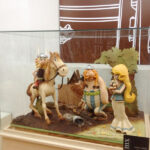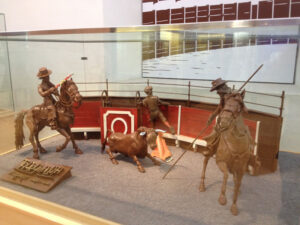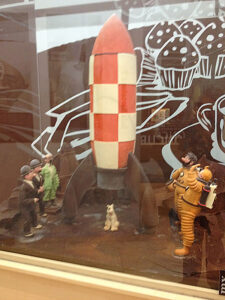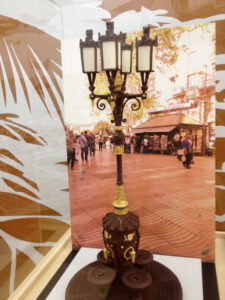The Sweetest Museum in Barcelona
By Michele Reed
bazanreed@hotmail.com
Photos by Bill Reed

It’s my favorite season in Central New York. No, not late winter. Chocolate season.
From mid-January to April, chocolate-shop windows and supermarket shelves are overflowing with everything from heart-shaped boxes of gooey goodness to creme-filled eggs and giant chocolate rabbits.
If you’re like me, you consider chocolate to be the food of the gods. Science seems to agree, as its scientific name is theobroma cacao, which means food of the gods in Greek.
All this yummy abundance puts me in mind of the sweetest museum we encountered on our European adventures: Museu de la Xocolata or the Museum of Chocolate in Barcelona.
This little gem is literally around corner, steps away from our favorite hotel in the Spanish city. One day, wondering what the big MX logo on the front of an otherwise non-descript brick building stood for, we entered.

The museum is a project of the Gremio de Pasteleria de Barcelona, or the pastry makers guild of Barcelona. It’s housed in an ancient building in the Born section of the Old Town, the medieval heart of the city. The structure is reputed to be either a barracks or a former convent, as if anyone needed further proof of the confection’s heavenly origins.
The sweetness begins as soon as you walk in the door. Your admission ticket is a miniature candy bar, its label adorned with the flag of your home country. After the entrance clerk scanned our bars, he handed them back to us as edible souvenirs of our visit.
Visitors start their tour learning about the cacao plant itself and its cultivation by ancient cultures of Latin America. The ancient Aztecs concocted a drink from the beans of the cacao plant, believing the resulting drink useful as medicine, to give them power in battle and as an aphrodisiac. (No wonder it’s a favorite Valentine’s Day gift.) It became an important part of Aztec and Mayan culture.
Spanish explorers to the New World brought the drink back to Spain. Barcelona became a major port for importing chocolate to the European continent, and a rich culture of enjoying the products made from it rose up in the city, and spread throughout Europe. Hot chocolate became a favorite drink, often with churros, or fried dough sticks to dip into it, giving rise to cafes serving the beverage. Artisan chocolate makers fed Europeans’ hunger for the new food, and bonbonerias or candy shops sprung up on every corner.


After absorbing the history and culture surrounding the delicious confection, visitors enter the gallery of chocolate creations. This area is carefully temperature-controlled, and the sculptures are enclosed in glass cases. But the aroma of chocolate pervades the air, making the museum a true feast for the senses.
Famous artworks and figures from history and literature are reproduced in chocolate throughout the space. There’s a chocolate Don Quixote and Sancho Panza, setting off on their quest. Tintin of French comics fame and his faithful dog, Snowy (rendered in white chocolate), stand ready to board a rocket for a trip to outer space. From another French comic, Asterix the Gaul and his sidekick Obelix prepare for a more down-to-earth adventure.
An entire room is devoted to famous Barcelona buildings and visitors can gawk at a magnificent replica of Sagrada Familia or an ornate replica of a Modernista streetlight, adorned with gold leaf.
After the sculpture portion of the museum, the tour includes a display of the candy-making process, with the machinery used to produce the chocolate and molds for fancy bonbons.
Conclude your visit with a stop at the café for hot cocoa and pastries or visit the store and load up on chocolate souvenirs for the whole family.
Barcelona is rich in history, culture and art, but the sweetest little corner of the city is definitely the Museum of Chocolate.

